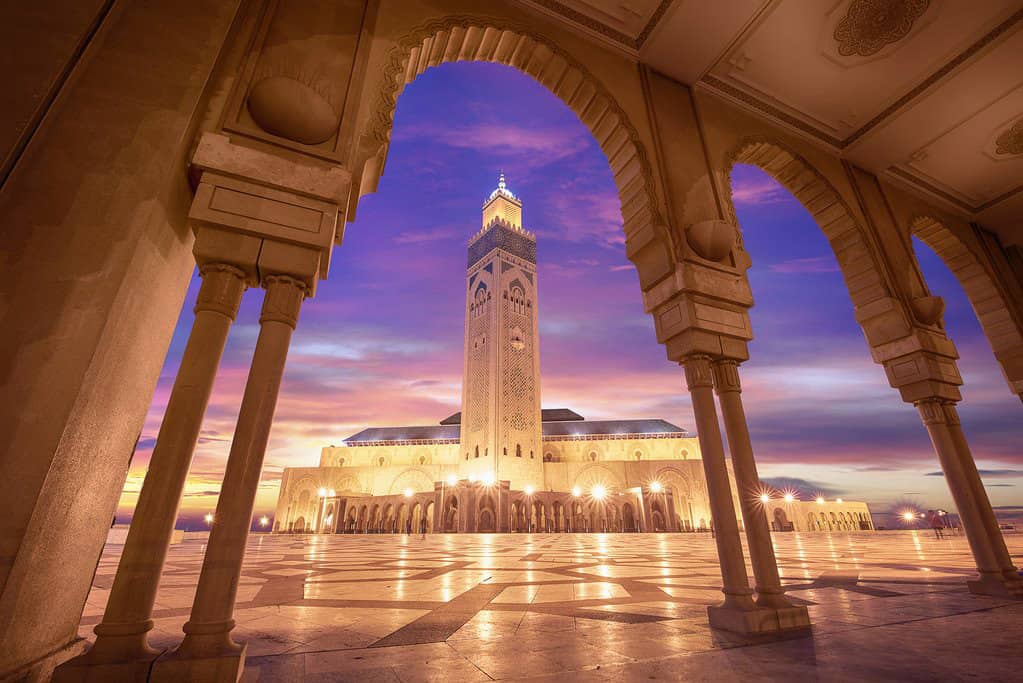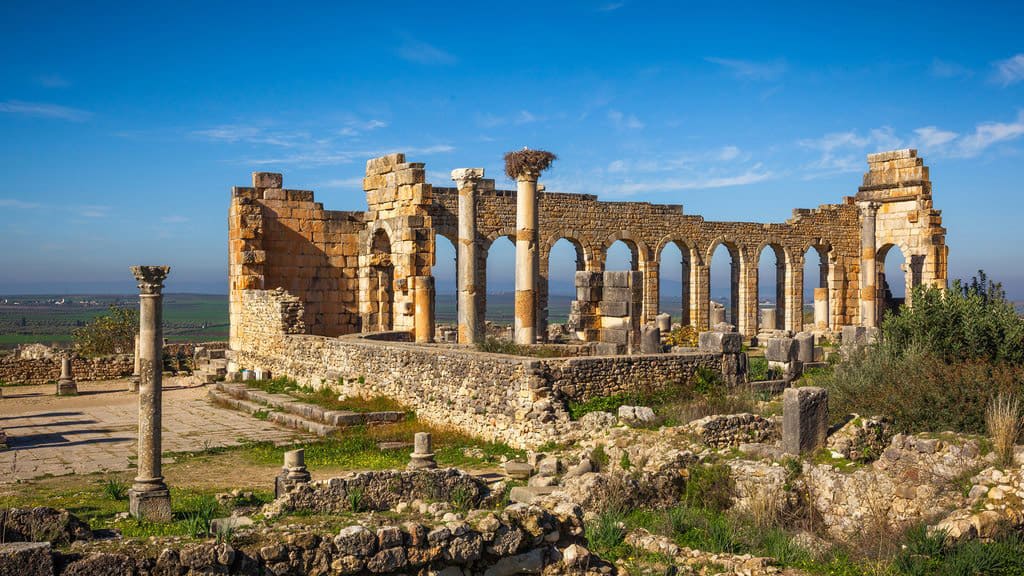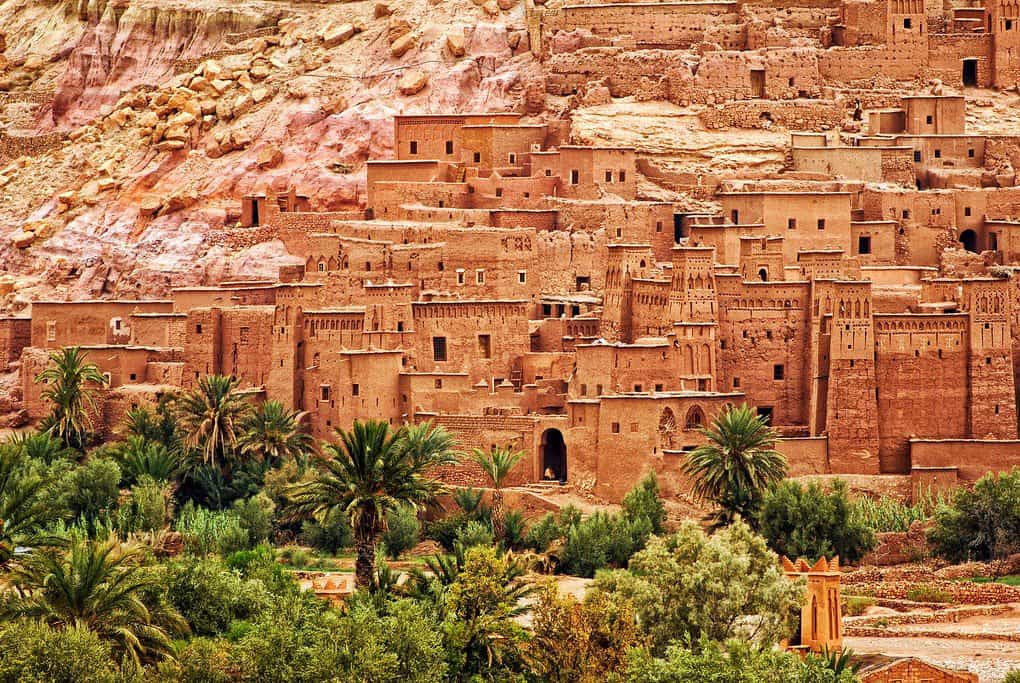Best of Morocco: Casablanca to Marrakesh
From Casablanca
11 Days
Overview
From the blue medina of Chefchoauen to the red dunes of the Sahara, this colorful, 11-day journey through Morocco has it all. The trip begins in Casablanca, home to one of the tallest mosque towers in the world, and then takes you to Fez, with its ancient, well-preserved square and unique tanneries. Enjoy camping under the stars in the Erg Chebbi Dunes, and take in the lively culture in Marrakesh.
Details & Itinerary
Day 1: Arrive in Casablanca, Transfer to Rabat
Welcome to Morocco! You’ll arrive in Casablanca and meet your driver outside the airport. Once you are settled in your lodging, begin with a visit to Hassan II Mosque, the largest in Morocco and the third-largest mosque in the world that non-Muslims are allowed to enter. Able to accommodate up to 105,000 in prayer, this marvel of modern Moroccan architecture is the work of hundreds of expert craftsmen from around the country, many of them donating their work.
Then, the trip continues to Rabat, where you’ll visit the Hassan Tower, which has sat unfinished since 1199. Commissioned by Abu Yusuf Yaqub al-Mansur, the tower was to be the minaret for the largest mosque in the world. Unfortunately, when the Sultan passed away in 1199, the project was abandoned, leaving some partial outer walls, 348 columns, and a minaret only standing half-finished at 140 feet rather than the intended 260 feet.
Standing opposite the Hassan Tower is the Mohammed V Mausoleum, which contains the tombs of Mohammed V, the current king’s grandfather, as well as the king’s father, Hassan II, and his uncle, Prince Abdallah. It is considered a masterpiece of Alaouite architecture with its white walls and green tiled roof.
Take some time to relax on your own after a long and eventful first day.
Day 2: Travel to Chefcahouen
Today, you will make your way to Chefchaouen. This little city is a visual delight in blue; walls, doors, windows, stairways, alleyways, and archways–everything is a combination of pastel, sky-blue and deeper, more powerful hues. Chefchaouen is located in the heart of the Rif Mountains and is popular for travelers who want to get the feeling of old Morocco.
After check-in at your riad (a traditional Moroccan house), you are free to explore the town at your own pace or simply relax. Place Outa el Hammam, the main square, is a place to watch the world go by. Walk up the tiny higgledy-piggledy alleys away from the touristed areas and you will find the everyday life of the town. Shopping here is great for the budget-conscious, and you will be able to find handcrafted wool garments, woven blankets, cedarwood furniture, and other artisanal work. Be sure to order a Maqlouba (upside-down) coffee and enjoy it while watching the local women retrieve water and wash their laundry in the nearby spring.
Enjoy dinner on your own before retiring for the evening.
Day 3: Travel to Fez
Today, you will say goodbye to Chefchaouen and travel south to Fez. Before you leave, you have time for a bit more exploration in the medina. You can watch the sunrise from the Spanish mosque if you wake up early enough, or you can spend a relaxing morning watching the city come to life from a café in Place Outa el-Hammam.
On the way to Fez, you’ll visit Volubilis, a UNESCO World Heritage Site that contains Morocco’s best-preserved Roman ruins. You can take a nice break from driving to wander the massive complex, exploring large merchant homes with visible heating systems, temples, and many well-preserved mosaics. There are usually guides available here to hire on your own if you would like, and your driver can assist you with this.
Then, it is over to Moulay Idriss, which from a distance, looks like a sitting camel. Moulay Idriss was founded in 789 CE by Moulay Idriss after he had fled religious and tribal conflicts in Mecca. It was here that he founded the Idrisid dynasty, making Moulay Idriss Morocco’s first Islamic capital and a site of ongoing cultural significance. The city also contains the only round minaret in Morocco. You can eat lunch here, or wait to eat at the next stop.
The last stop before Fez is the prosperous city of Meknes. It has a smaller medina than Fez and you can explore at a leisurely pace, without worrying about aggressive shopkeepers. Your driver will lead through the Ville Impériale area, where you can see gardens, palaces, the impressive gate of Bab al-Mansour, the Mausoleum of Moulay Ismail, and the Royal Stables. Many of these palaces were constructed with materials taken from Volubilis, so be on the lookout for Roman columns hidden in unexpected places!
You’ll end the day in Fez, one of Morocco’s four imperial cities. Fez was founded by Moulay Idriss I and was made the capital of the Idrisid dynasty by his successor, Moulay Idriss II. You will be taken to your riad in the Fez medina, and the late afternoon into the evening will be yours.
The ancient and unforgettable Fez Medina is a maze of winding alleys that climb up both sides of a steep river valley and is the largest car-free urban area in the world. You are likely to get lost while exploring the Fez medina on your own, but this can also be liberating! The secret to finding your way out of the medina is to pay attention to whether you are going uphill or downhill as you walk. Walking uphill will generally take you to the edge of the medina, where you can catch a taxi or more easily see where you want to go.
Day 4: Day tour of Fez
Good Morning! Today, you’ll tour Fez with a private guide. Prepare for plenty of walking, although you will take a vehicle to some areas. You can expect to:
- Begin at the Royal Palace, with its seven golden doors, and learn about the significance of the intricate decor.
- Stroll through the Mellah, or Jewish quarter, which was built next to the palace to offer protection.
- Take in the view of the city from Borj Sud, a former fortress and one of the lookouts on a hill where you can see all of Fez laid out, allowing you to spot landmarks otherwise hidden by the skyline-obscuring buildings.
- Visit a pottery co-op to see how unique Fez pottery is made, as well as how the artisans handcraft the intricate mosaics adorning half of Morocco.
- Head into the ancient medina and step into a sort of living museum. The Fez medina is very much a local community that lives and works and goes about daily life in the medina, so be sure to keep moving and watch out for the donkeys!
- Stop by the Al-Quaraouiyine University, the oldest degree-granting university still in operation, having been founded in 859 CE by a woman.
- Visit handicraft workshops, where you will see why Fez is considered the handicraft capital of Morocco. This can include, among other things, the silk weavers, where beautifully colorful fabrics are woven from silk fibers of the agave plant, and the famous Fez tannery, where they process all manner of animal hides by hand, much as they have for nearly 1,000 years. They also sell leather items in every shade and style, and can even alter an item to be delivered to your riad by the end of the day!
During your tour of the medina, you will stop for lunch in a restaurant that would be very easy to walk right past, but is truly a hidden gem. After a long day of touring, take the evening to enjoy at your leisure.
Day 5: Travel to Merzouga
After breakfast, you will depart Fez and begin your journey south. You’ll make a coffee stop in Ifrane, a small ski resort town that is also known as the “Switzerland of Morocco,” due to its alpine-style architecture. Then visit with the wild monkeys in the cedar forests outside of Azrou, where they are happy to be fed and are surprisingly well-mannered.
In the afternoon, stop in Zayda for lunch, where you can enjoy the fresh barbecue in one of the many streetside restaurants. Continue on your journey, and note the beauty of the Atlas Mountains surrounding you. Look out for the lush, green date and almond trees filling the gorge in Errachidia.
You’ll arrive in Merzouga in the evening and check in to your riad in time for dinner.
Day 6: Sahara Desert Excursion
Begin your day with a one-hour quad excursion through the Sahara Desert. Take in the exhilaration of speeding through the sands and up the dunes, where you will stop to enjoy a peaceful moment with just sky and sand for as far as you can see. You will have a professional guide to ensure you don’t get lost!
After your return, meet your SUV driver for an even longer journey through the Sahara. You’ll stop for tea with a nomadic family in their winter home. The nomads herd sheep and goats from the Atlas Mountains to the Sahara Desert, moving with the weather.
Then, visit the Gnawa Village to listen to entrancing music. The rhythmic, hypnotic music has long been part of the desert ceremonies, from the time the Gnawa ancestors were brought to the area as slaves. The music has influenced an entire genre that is performed all across Morocco and has even inspired several music festivals. Next, you can hunt for fossils of aquatic critters in the desert. The Sahara was once an ocean, 7 million years ago, and there are countless fossils remaining.
In the late afternoon, meet your camel for your trek to your desert camp. You will journey through the dunes, and your camel guide will be able to get some great pictures for you, as well! Arrive at your camp and enjoy a welcome glass of mint tea and some Moroccan cookies. Take some time to relax before dinner, and then enjoy live music around the bonfire at nightfall.
Day 7: Travel to Boumalne Dades
If you are an early riser, you can wake up early to watch the sunrise over the dunes. Remember, it gets cold in the desert overnight, so don’t forget your jacket! Enjoy a traditional Moroccan breakfast at the camp, and depart via camel (or SUV if one camel ride was enough for you).
Next, meet up with your driver, and begin your journey west. You’ll make a stop in Boumalne Dades to see the stunning Todra Gorge, carved from the red rocks of the landscape by a river.
Then, check in to your accommodations in Boumalne Dades before you head to Rose Valley for a guided hike, which can be as relaxed or as challenging as you’d like.
Relax and enjoy dinner at your riad in the evening.
Day 8: Travel to Marrakesh
In the morning, you’ll make your journey to Marrakesh. If you’d like, you can request to make a stop in Kalaat M’Gouna, which is famous for its rose co-ops, where thousands of pounds of rose petals are harvested each year to be distilled into rose water and rose oil for use in cosmetics.
Next, you’ll reach Ouarzazate, where you’ll make a stop at Ait Benhaddou, an ancient Ksar that has been named a UNESCO World Heritage Site. Located along the former trade caravan route between the Sahara Desert and Marrakesh, the Ksar is now often used as a filming location for movies including The Jewel of the Nile, The Mummy, Gladiator, and Kingdom of Heaven.
You’ll continue across the Atlas Mountains via the winding Tichka Pass to arrive in Marrakesh in the late afternoon. Check in to your riad, which is located in the medina, and take a stroll in the evening.
Day 9: Day tour of Marrakesh
In the morning, prepare for your tour of Marrakesh with a private guide. There is much to see and do around town. Expect to:
- Visit the Koutoubia minaret, the tallest in Marrakesh. Within the city walls, no building is allowed to be taller than the Koutoubia’s 253 feet. The minaret is part of the largest mosque in Marrakesh, which was completed in 1199.
- Stop at a Berber Apothecary shop, learning of the medicinal uses of many of the common spices and herbs that are still used across Morocco to treat common illnesses. While it’s not as picturesque as the heaps of spices you find in the market, it is far more informative!
- Tour the Bahia Palace, a late 19th-century palace built for the grand vizier and named for his favorite wife. The rooms, set in a 2-acre garden, include the rooms which housed his harem, which was often a political position.
- Explore Jemaa el Fna, the primary square in the medina and a UNESCO World Heritage Site. Though now filled with street performers, snake charmers, merchants, and orange juice stalls, when it was created in 1050, it was used for public executions, perhaps leading to its name which can be translated as “Assembly of Death.”
- Head into the souks surrounding Jemaa el Fna to several workshops, including those of shoemakers and bakers.
If you’d like, you can spend the afternoon exploring the souks with the guide, who can help you navigate the winding alleys to find exactly what it is you seek. Once your tour is complete, enjoy the evening on your own time.
Day 10: Free day in Marrakesh
Today, enjoy a free day to explore Marrakesh. You may choose to visit museums, such as the Yves Saint Laurent Museum and Berber Museum to start. You can also tour the Majorelle Garden with its 300 plant species.
If you are seeking some relaxation, indulge in a traditional hammam visit, which includes being covered in black beldi soap, scrubbed with an abrasive kessar mitt to remove dead skin, and relaxing in a steam room. This is a must if you enjoy spa treatments.
You can also enjoy exploring the bustling city, wandering the souks and people-watching from streetside cafés. In the evening, unwind at Jemaa el Fna, and watch the square come to life on your final night in Morocco.
Day 11: Depart from Casablanca
After breakfast, check out of your hotel in Marrakesh. Then, you will transfer to the airport in Casablanca for your departure flight. Take note to arrive at the airport three hours before your departure time, as the airport can get very backed up. Say farewell to Morocco and all of its well-preserved beauty–until next time!
Tour Itinerary
Day 1 –Arrive in Casablanca, Transfer to Rabat
Day 2 –Travel to Chefcahouen
Day 3 –Travel to Fez
Day 4 –Day tour of Fez
Day 5 –Travel to Merzouga
Day 6 –Sahara Desert Excursion
Day 7 – Travel to Boumalne Dades
Day 8 –Travel to Marrakesh
Day 9-Day tour of Marrakesh
Day 10-Free day in Marrakesh
Day 11-Depart from Casablanca
What’s Included
Planning and quality control by seasoned travel leaders
Knowledgeable Guides (Multi-lingual), special lectures, and insightful meetings
Entrance Fees to Historic Monuments
All Transfers-even individual airport transfers, when required.
Luggage Handling-at all hotels, airport, etc.
Air-Conditioned, comfortable, and luxurious vehicles depending on your choice (4*4, Mini-bus…).
Nights at the top range hotels, Riads, Kasbahs, and Bivouacs.
Elegant Meals (Breakfast daily, and usually either Dinner).
All details are handled by reliable, experienced Tour Leaders.
Outstanding value and convenience.
No hidden add-ons or markup.
What’s Excluded
Lunchs
Tips
Travel insurance charges
Travel Advices
_
_
Best time to visit Morocco
The climate in Morocco varies wildly according to the season and area of travel. In the lowlands, the cooler months from October to April are popular among visitors. This time of year is pleasantly warm to hot (around 30°C) during the day and cool to cold (around 15°C) at night. Winter in the higher regions often brings snow and can therefore get seriously cold, particularly at night. Tourists flock to the coastline from June to September for fun in the sun, with warm mostly rain-free days. Further inland it can get hot and rain is rare, which makes the best times to travel March to June and September to December.
Morocco Culture & Customs
Morocco's culture has developed over centuries of influence from far and wide. Contemporary Morocco is a fascinating mix of Berber, Mediterranean, Andalucian, and African traditions, which are present in the cuisine, clothing, music, language, customs, and lifestyle. As an Islamic country, most Moroccans are Muslim; however, there are small populations of people who practice Judaism and Christianity. Classic examples of Islamic architecture can be observed all throughout the country and tenets of the Islamic religion are carried out in the customs and lives of the people. The 'Call to Prayer' can be heard five times a day, women are expected to dress modestly and alcohol isn't drunk by most of the population.
Most of Moroccan society can be considered traditional, with respect for elders, connection to family, and giving alms to the poor hallmarks of everyday life for many Moroccans. Hospitality is another important element of society, with warmly welcoming people into your home a time-honored tradition and social responsibility that dates back centuries.
Vegetarian and Vegan Options in Morocco ?
Much of Morocco's cuisine revolves around meat, but vegetables are an important staple and a crucial ingredient in many dishes of the Maghreb. Your diet can consist of more than just flatbread and hummus – trust us. Keep an eye out for vegetable-based tagines and couscous, the renowned Zaalouk (a smokey eggplant and tomato salad), vegetable Briouats (triangular-filled pastries), and cinnamon oranges. Vegan options are slightly more limited, as many of the pieces of bread and couscous dishes have butter added to them, but your best bet is to enquire if yours can be made using oil instead. Otherwise, it's easy to dine well on varied vege offerings in Morocco.










